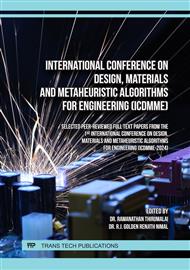[1]
Ahiduzzaman, M.; Sadrul Islam, A.K.M. Greenhouse gas emission and renewable energy sources for sustainable development in Bangladesh. Renew. Sustain. Energy Rev. 2011, 15, 4659–4666.
DOI: 10.1016/j.rser.2011.07.086
Google Scholar
[2]
Anik Deb, Dr. Mahmud Abdul Matin Bhuiyan, Arefin Nasir "Prospects of Solar Energy in Bangladesh", IOSR Journal of Electrical and Electronics Engineering (IOSR-JEEE) e-ISSN: 2278-1676 Volume 4, Issue 5 (Jan. - Feb. 2013), PP 46-57.
DOI: 10.9790/1676-0454657
Google Scholar
[3]
Anik, D.; Mahmud, A.M.B.; Arefin, N. Bangladesh prospects of solar energy in Bangladesh. IOSR-JEEE 2013, 4, 46–57
DOI: 10.9790/1676-0454657
Google Scholar
[4]
Bangladesh Power Development Board (BPDB), Bangladesh. Available online: www.bpdb.org.bd (accessed on 9 October 2017).
Google Scholar
[5]
Biowaste to Biogas! Available online: https://d2oc0ihd6a5bt.cloudfront.net/wp-content/uploads/sites /837/2016/03/B2_1_STRIPPEL-Florian_German-Biogas-Association.pdf (accessed on 8 November 2017).
Google Scholar
[6]
CO2 emissions (metric tons per capita). Available online https://data.worldbank.org/indicator/en.atm.co2e.pc?locations=bd (accessed on 12 October 2017).
Google Scholar
[7]
Green House Gas Emissions in Bangladesh. Available online: https://www.climatelinks.org/sites/default/files/asset/document/ghg%20emissions%20factsheet%20bangladesh_4-28- 16_edited_rev08-18-2016_clean.pdf (accessed on 12 October 2017).
Google Scholar
[8]
Hossain, M.A.; Hossain, M.Z.; Rahman, M.A. Perspective and Challenge of Tidal Power in Bangladesh. World Academy of Science. Eng. Technol. 2014, 8, 1140–1143.
Google Scholar
[9]
International Renewable Energy Agency (IRENA). Biogas for Road Vehicles: Technology Brief; International Renewable Energy Agency: Abu Dhabi, Arab Emirates, 2017.
Google Scholar
[10]
Islam, M.M.; Das, N.K.; Ghosh, S.; Dey, M. Design and implementation of cost effective smart solar charge station. In Proceedings of the 2014 9th IEEE International Forum on the Strategic Technology (IFOST), Cox's Bazar, Bangladesh, 21 October 2014; p.339–342.
DOI: 10.1109/ifost.2014.6991135
Google Scholar
[11]
Jenkins, S.D.; Rossmaier, J.R.; Ferdowsi, M. Utilization and effect of plug-in hybrid electric vehicles in the United States power grid. In Proceedings of the 2008 IEEE VPPC'08 Vehicle Power and Propulsion Conference, Harbin, China, 3–5 September 2008.
DOI: 10.1109/vppc.2008.4677501
Google Scholar
[12]
Number of registered motor vehicles in Bangladesh. Available online: http://www.brta.gov.bd/newsite/wpcontent/uploads/2016/07/statistics-bangladesh-june16.pdf (accessed on 14.01.2018)
Google Scholar
[13]
PDB bringing battery run vehicles tariff regulations Available online: http://www.dhakatribune.com/bangladesh/power-energy/2017/09/27/pdb-bringing-battery-run-vehicles-tariffregulations/ (accessed on 14.01.2018)
Google Scholar
[14]
Per capita energy consumption and Share of clean energy, Available online: http://www.theglobaleconomy.com/Bangladesh/Share_of_clean_energy/ (Accessed on 14.01.2018).
Google Scholar
[15]
Rahman, M.M.; Paatero, J.V.; Lahdelma, R. Evaluation of choices for sustainable rural electrification in developing countries: A multi-criteria approach. Energy Policy 2013, 59, 589–599.
DOI: 10.1016/j.enpol.2013.04.017
Google Scholar
[16]
Sarkar, M.S.; Sadeka, S.; Sikdar, M.M.; Zaman, B. Energy Consumption and CO2 Emission in Bangladesh: Trends and Policy Implications. Asia Pac. J. Energy Environ. 2015, 2, 175–182.
DOI: 10.18034/apjee.v5i1.249
Google Scholar
[17]
Sustainable and Renewable Energy Development Agency (SREDA), Bangladesh. Available online: www.sreda.gov.bd (accessed on 9 October 2017).
Google Scholar
[18]
Tulpule, P.; Marano, V.; Yurkovich, S.; Rizzoni, G. Energy economic analysis of PV based charging station at workplace parking garage. In Proceedings of the 2011 IEEE Energy Tech, Cleveland, OH, USA, 25–26 May 2011; p.1–6.
DOI: 10.1109/energytech.2011.5948504
Google Scholar
[19]
World Energy Insight 2012. Available online: https://www.worldenergy.org/wp-content/uploads/2012/10/PUB_World-EnergyInsight_2012_WEC.pdf (accessed on 12 October 2017).
Google Scholar
[20]
Yousuf, S.A.; Venayagamoorthy, G.K. Plug-in vehicles and renewable energy sources for cost and emission reductions. IEEE Trans. Ind. Electron. 2011, 58, 1229–1238.
DOI: 10.1109/tie.2010.2047828
Google Scholar


